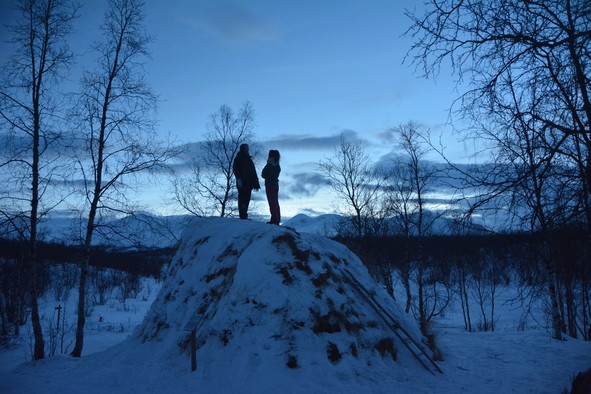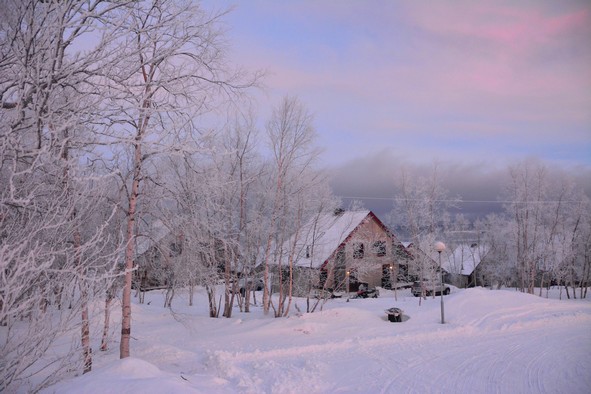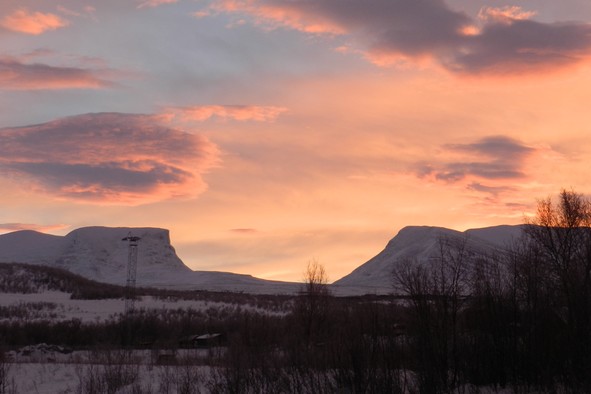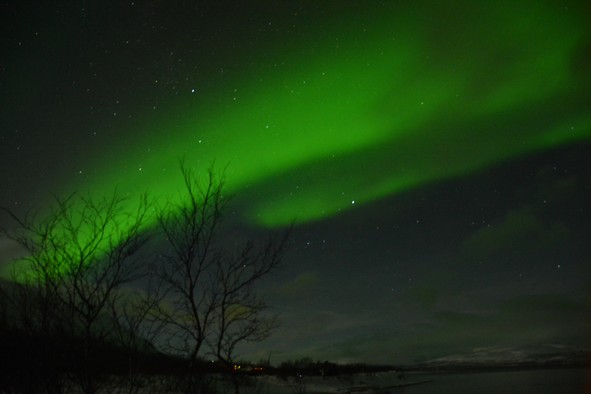95 km north of the Arctic Circle, Swedish Lapland is a peaceful haven where empty, snowy landscape seems to stretch endlessly on. One of the best spots in the world for stargazing, the area is often graced by the aurora borealis at night. Lapland is historically inhabited by the Sámi people, and home to a unique nomadic culture designed to withstand even the harshest meteorological conditions.

Goathi shelter at a reconstructed Sámi camp, Abisko National Park (Photo: Rodrigo Kleinert)
The Waiting Game
Tripod firmly anchored in snow hardened by the cool wind of the late hours, Rodrigo has his right eye glued to his camera, snapping pictures of the sky on a low-shutter speed. “I can see traces of them!” he exclaims every now and again, warm wisps of breath hitting the icy air. “Really?” I respond jaded, well aware that whatever his camera is picking up is invisible to the naked eye.
Night after night we stand knee-deep in the snow, wishing away the clouds cluttering our view of the sky. It’s the last night of our five day trip to Abisko National Park and our impatience is palpable. We look up and strain our eyes for a tell-tale clearing that might reveal the notorious emerald spectacle we have come so far north to witness. But the nights have come and gone without a trace of the famous northern lights. Instead, we have spent them gazing at star spatterings of an intensity we’ve never beheld before in our light-polluted city lives. Still, we silently hope that the ultimate magic might happen before the end of the night.

The view over Torneträsk lake, Sweden (Photo: Rodrigo Kleinert)
Crumbling Kiruna
We had flown from Stockholm up to Kiruna, the northernmost town in Sweden. Though it was barely midday when we landed, the sky was pink and the air was cutting. An old friend of ours and local to the area, Cecilia was waiting for us outside the airport, geared up in heavy-duty coat that made her look twice her usual size. She ushered us into the warmth of her car quickly, throwing our bags in the boot.
I waved a patch of window clear of fog. Beyond the glass I could see brave locals with weathered faces shuffling in winter boots along snow-crusted streets, some pushing children or bags of shopping home on elegant wooden kicksleds. Cecilia started to tell us a bit about Kiruna, built on an iron ore mine in 1900. She had grown up in this isolated town, built as a home for miners and their families. Even through the harsh winters the miners continue to dig and extract, dragging iron ore up from deep in the earth, and staining the snow with black dust.

Kiruna Kyrka, Kiruna (Photo: Allison Stillwell Young via Flickr)
“It’s growing unsafe they say,” Cecilia sighed, “to live perched on the thinning mine. Cracks have started to creep up buildings and they’re worried everything will collapse”. I couldn’t shake the idea that we were driving over an egg shell. Rodrigo asked if she was worried about her family home. “Well, the town is to be dismounted” she explained, “packed up and moved like a travelling stage set. Brick by brick, road by road. The whole town will slowly disappear and rise again 40kms west of here.”
We drove on in silence. “See that church?” Cecilia continued, pointing ahead, “my parents were married there. It’s one of the biggest wooden cathedrals in Sweden. I’ll bet the reconstructed one won’t feel quite the same to them. The Sámi no doubt won’t like it either. The church was built in 1912 in Sámi-tent style and people celebrate it as the shrine of the nomads.”
The fate of Kiruna seemed unbelievable: this lived-in city vanishing to reappear as a distorted version of itself elsewhere. Over a hundred years of goings-on in the town would be transfigured. I wondered at the games it might play on locals’ minds and memories.
The Road to Abisko
After stopping off for supplies we set off on the lone road from Kiruna to Abisko – Ábeskovvu in the language of the indigenous Sámi. The Torneträsk lake spread out to our right; low lying hills lay to our left. As we spotted reindeer in the emptiness, we enjoyed the sight of modern-day Sámi herders on snowmobiles guiding them in their winter grazing.

Reindeer grazing, Abisko National Park (Photo: Rodrigo Kleinert)
Fields of wind turbines emerged as we drove on, almost camouflaged against the snow. Pine trees stretched on endlessly, interrupted only by a lonely railway track snaking its way across the landscape. Bursts of light flashed from the overhead cables as it darted through the snow. Passing through at full speed, a fierce chug occasionally broke the silence, carrying cargo and passenger trains on the long journey from Stockholm to Narvik, Norway.
An hour on the road and we arrived at the national park, to a snow-globe scene of wooden cottages isolated and quiet beneath the peachy sky. The trees looked dramatic in their nakedness, leaves replaced by coats of frost, brittle and hair-thin. Chimneys were hard at work against the cold, smoking day and night beneath roofs sporting fat coats of snow. As Cecilia fiddled for the keys to our own cottage I looked up at the dribbling icicles hanging from the roof edge, wondering if one might dart down onto me.

Turiststation STF, Abisko National Park (Photo: Rodrigo Kleinert)
Sunrise-Sunsets
The following morning we woke early, but at 10 o’clock the sky still held the weight of night. It was early on in January, during the period of polar nights. Though the sun would tease the horizon, it would not rise above it at all. The sky would turn a luminous pink before falling into orange sunset, skipping the blue-sky phase we’re so accustomed to. Hungry for daylight, we’d spend the four hours of light cross-country skiing across the empty landscape, on the footsteps of the Sámi.
As we slid across fields of snow in long, thin skis we marvelled at the remoteness of the area. In places, the distinction between snow, ice and water was so subtle I was sure it had deceived many. We barely crossed paths with a soul, except a group of joyful visitors racing through on sleds pulled by panting huskies. They stopped to greet us, and one of the huskies approached. I ran my hand through his thick coat, and stared right into his ice-blue eyes. When they took off again vanishing between clusters of pine tree, all they left behind was a glimmering trace in the snow.

Sunrise beyond the branches, Abisko National Park (Photo: Rodrigo Kleinert)
Seeking Out the Sámi
We kept moving and I wondered how indigenous populations had managed to sustain themselves here in extreme conditions for such a long time. The Sámi we knew were those flaunted by the tourist industry: colourful gátki clothing, embroidered mittens and reindeer fur hats. The representation was appealing and I felt drawn to it at first. But the ‘authentic’ Sámi meals, ice fishing, and reindeer-lassoing activities lost their appeal in contrast with the indigenous peoples’ shadowy actual presence in the area.
In the early afternoon we stumbled upon a reconstruction of a late-19th century Sámi camp. Though geared at tourists staying in the area, the clearing was deserted; it felt as though the nomads had just abandoned this camp for the next one. Nightfall was near. I couldn’t help but draw a parallel between the camp and the state of Sámi culture in Sweden today: a showpiece faltering beyond that facade.
We hurried to explore before dark, contemplating the resourcefulness of the indigenous people. I peered into a temporary goathi shelter first: thick walls of moss and peat set upon a structure of branches bent to a rounded shape. An earthy, sturdy counterpart to the igloo in shape and size. On a massive tree trunk sat a wooden food storage hut – well off the ground with a ladder leading up to it; a cunning structure to keep the goods out of reach of wandering animals.

Lapporten or ‘The Gate to Lapland’, Absiko National Park (Photo: Rodrigo Kleinert)
We clambered up a ladder onto the roof of a mounded storage space for furs and foods on the ground. From our perch, Cecilia pointed to a grandiose, semicircular valley between the Nissuntjårro and Tjuonatjåkka mountains. “We call it Lapporten” she said, “the Gate to Lapland”. It was breathtaking. I marvelled at how the view must hardly have changed since the Sámi were on their journeys across the land here. “Why don’t we come back here for the lights?” Rodrigo suggested.
Last Chance
So here we stand on our mound. It’s past midnight and our excitement has fizzled out. We are losing hope altogether and contemplating bed when something flickers in the corner of my eye. Before I’ve even realised it’s happening, Cecilia grabs me. A faint green light appears; a streak across the sky. “This is it!” she blurts out in a high-pitched whisper, as though worried the sound of her voice could scare the spectacle away. We all stay still, frozen in our positions. Even Rodrigo is unstuck from his viewfinder for an instant.
Lulled to life, the budding light brightens. My stomach lurches in anticipation; I turn to the others and grin. They edge closer to me and we link arms, bound like the fingers of a hand. All sense of time and cold vanishes as our long-awaited guest sweeps across the sky, eclipsing the stars in its midst. Bright and slow-moving the light flickers, undulating like a length of emerald ribbon unfurled from its spool.

Aurora borealis, Abisko National Park (Photo: Rodrigo Kleinert)
No photograph has geared us up for this new and uncanny experience. We watch entranced as the rhythm of the light speeds up. Streaks of purple fluctuate around the green light as quivers. It brings to my mind a coquettish dancer in elaborate dress, swirling across a dance floor. The beauty of the moment is overwhelming; none of us have any idea how long we’ve been standing here for.
It is only when deep, inky night steals back its sovereignty that we feel the biting cold in our fingers and toes. We head back to the cottage and light a fire, animatedly chattering about the spectacle we have beheld. As I fall asleep, I start to think about the Sámi. What did it mean to them, I wonder. I think about whether they too, gathered around a campfire, felt such delight on the nights that the lights appeared above them. I like to think one could never tire of such exceptional natural beauty.